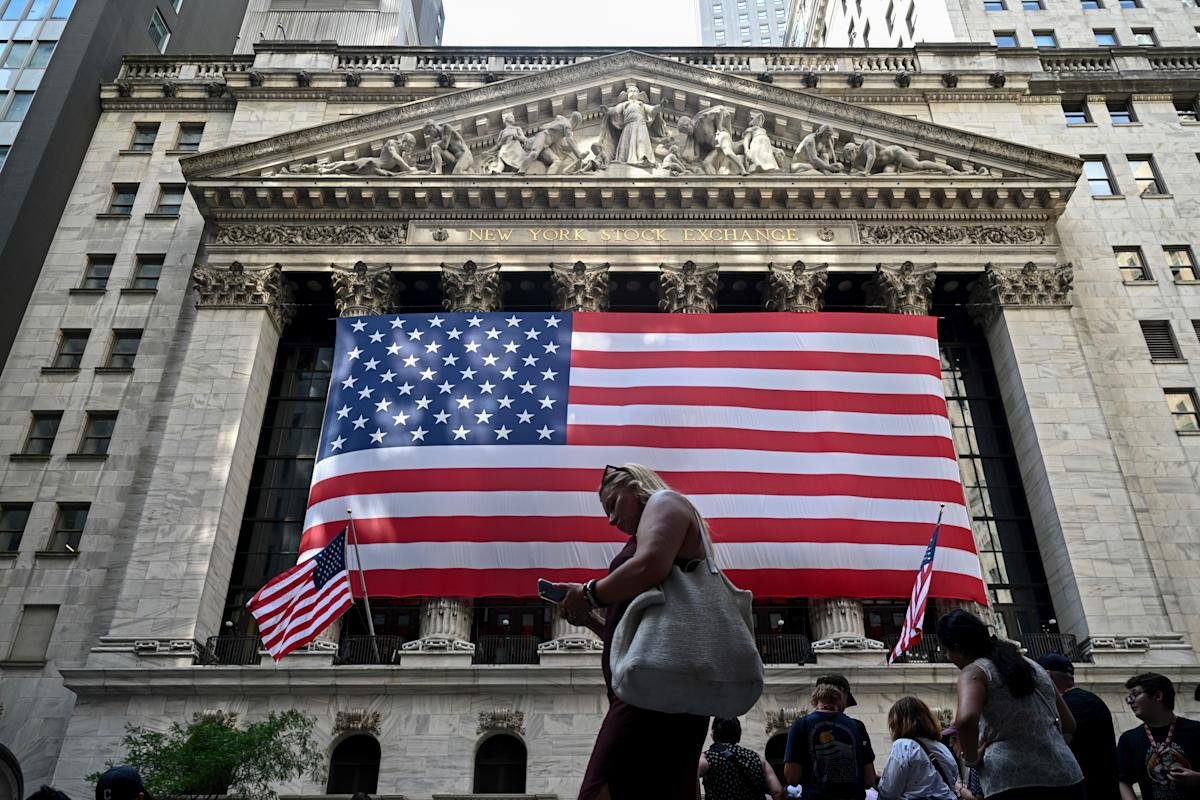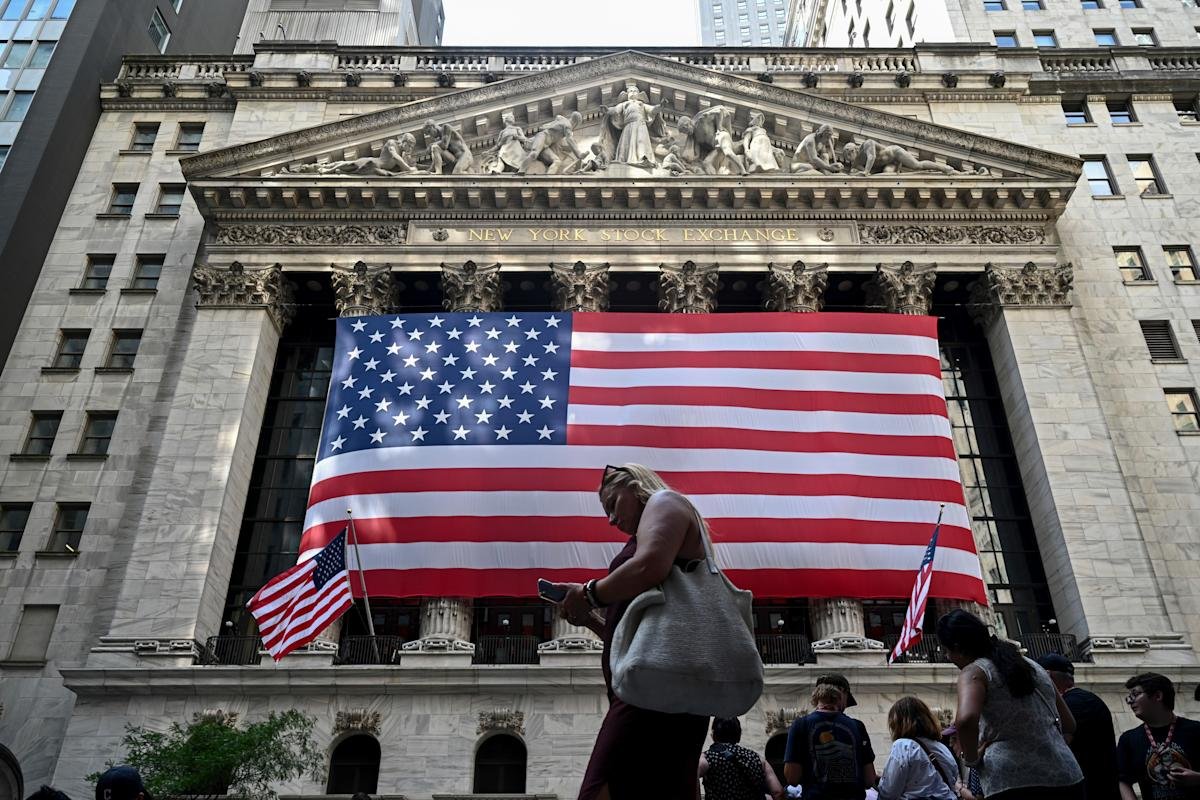Now Reading: Stock market retreats after record highs: US stock market today: Wall Street pauses near record highs as earnings, inflation expectations take center stage
-
01
Stock market retreats after record highs: US stock market today: Wall Street pauses near record highs as earnings, inflation expectations take center stage
Stock market retreats after record highs: US stock market today: Wall Street pauses near record highs as earnings, inflation expectations take center stage

For the week, all three major indexes remain on track for gains, with the S&P 500 up 0.8%, the Nasdaq ahead by 1.8%, and the Dow adding 0.2%.
How did the US stock market perform today?
S&P 500 (SPY) edged down slightly by about 0.08%, hovering just below record highs, suggesting cautious investor sentiment.
Nasdaq (QQQ) also drifted down around 0.10%, despite strong earnings enthusiasm from big tech names.
Dow (DIA) slipped approximately 0.54%, weighed down by modest declines in industrial and financial stalwarts.
Why did the S&P 500 ease after reaching a record high?
The S&P 500’s initial jump was driven by optimism around earnings and economic data. However, as traders digested the details, the market cooled. Despite hitting record territory, concerns around individual earnings reports and broader economic signals created a mixed trading mood.
American Express, a key component of the Dow, saw its shares fall 3% post-earnings, dragging the 30-stock index lower. Meanwhile, Netflix, even after reporting stronger-than-expected earnings, saw its stock drop 4%, showing how investors are reacting cautiously, even to good news.
Which stocks made the biggest moves?
Netflix (NFLX) was one of the session’s biggest losers, dropping over 5%, despite posting a second-quarter earnings beat and raising its full-year revenue guidance. Analysts pointed to Netflix’s high valuation and noted that its results simply weren’t enough to satisfy “elevated expectations.” The stock, already up more than 40% year-to-date, faced pressure as investors hoped for a more bullish outlook. American Express (AXP) also fell sharply, down 3.3%, despite surpassing earnings and revenue estimates. While consumer spending remained resilient—rising 7% year-over-year—executives noted a slight pullback in discretionary areas like travel. The company left its full-year guidance unchanged, which some investors saw as too conservative given current trends.
On the flip side, Charles Schwab (SCHW) gained nearly 2% after posting a 50% year-over-year jump in adjusted profits. The brokerage benefited from increased trading activity driven by market volatility linked to tariff-related headlines.
Industrial heavyweight 3M (MMM) also posted solid gains, rising more than 2.5% after beating second-quarter earnings and raising its full-year outlook—helped by stable demand and cost controls.
A surprise standout was Circle (CRCL), which rose over 3% intraday following the passage of the Genius Act, a groundbreaking stablecoin regulation bill. Analysts at Seaport Research raised their price target from $235 to $280, calling Circle the “purest stablecoin play” in the market. Since its IPO last month, Circle’s stock has surged over 600%.
Which stocks gained the most today?
- Tesla (TSLA) led the way with a +3.4% jump, boosting the tech-heavy Nasdaq and overall market optimism.
- Charles Schwab (SCHW) also surged +3.4%, fueled by strong quarterly profit growth .
- Norfolk Southern (NSC) climbed ~2.9–3% on news of potential merger talks.
- Utilities sector stocks led S&P sectors, rallying 1.7% on average.
- Chevron and Hess saw notable gains—Chevron rose on a legal win, and Hess jumped around 7.6% .
Other notable movers: Robinhood (+4.7%) and Coinbase (+6.4%) surged following crypto-related legislative news, and Talen Energy spiked around 15%+ in premarket trading on acquisition news
- Apple (AAPL) was flat, with a modest uptick of +0.14%.
- Nvidia (NVDA) edged slightly lower, down about 0.2% intraday.
These gains reflect broad strength across sectors today—tech and velocity boosts from Tesla and crypto, plus energy and utilities pushing forward.
Which stocks are leading the market action?
Nvidia continued its rally, inching up another 0.3%, maintaining its upward momentum that’s helped lift the tech-heavy Nasdaq. Tesla also saw a solid 3% gain, while Alphabet and Amazon edged higher.
Elsewhere, PepsiCo and United Airlines jumped earlier in the week after both beat earnings estimates, reflecting strong consumer demand and operational efficiency. Big banks like JPMorgan and Goldman Sachs also posted impressive numbers, adding support to the overall market tone.
So far, around 60 companies in the S&P 500 have released second-quarter earnings. According to data, 86% of them have surpassed analyst expectations, giving bulls more reason to stay optimistic.
The biggest stock losers today based on market performance:
- American Express (AXP) fell around 3% after its earnings report failed to impress investors despite meeting expectations.
- Netflix (NFLX) dropped about 4%, even though it posted better-than-expected earnings, as guidance and subscriber growth disappointed some traders.
- 3M (MMM) saw a slight decline despite reporting an earnings beat, as future outlook concerns weighed on sentiment.
- Biotech and healthcare stocks also underperformed, with select names dipping due to weak trial updates or lukewarm guidance.
- Travel-related stocks like some cruise lines and airlines edged lower after recent rallies, likely from profit-taking.
Overall, while the broader market held steady, these names faced pressure due to earnings reactions or sector-specific weakness.
What’s going on at the Fed?
Fed Governor Christopher Waller made headlines with his strongest call yet for a July rate cut. Speaking in New York, Waller argued the central bank should lower its policy rate by 125–150 basis points, bringing it down to 3%. He said any inflation stemming from Trump’s tariffs would likely be temporary and shouldn’t prevent action.
Waller, seen as a potential successor to Fed Chair Jerome Powell, added in a Friday interview that if President Trump offered him the top Fed job, he would accept—though he clarified that Trump “has not contacted me.”
Is the U.S. economy still showing strength?
Yes, the latest economic data suggests the U.S. economy remains resilient. Strong GDP growth projections and signs of cooling inflation have helped reinforce investor confidence.
“It’s a risk-on environment,” said Ken Mahoney, CEO at Mahoney Asset Management. He added, “While there’s chatter about Fed rate cuts, the reality is more nuanced. Historically, markets tend to perform better without cuts. But with inflation easing and GDP growth holding, there’s a valid case for a different outcome this time.”
How did earnings season shape this week’s rally?
Earnings were a key driver of the weekly rally. With a high percentage of companies beating expectations, confidence in corporate fundamentals remains strong. Investors were encouraged by the strength of sectors ranging from consumer goods to airlines and tech.
The S&P 500’s 0.8% weekly gain reflects that positive sentiment, even if Friday’s moves were muted. The Nasdaq’s 1.8% rise was boosted by mega-cap techs, while the Dow’s modest 0.2% gain shows mixed reactions in industrials and financials.
What should investors watch heading into next week?
As more companies continue to report earnings, attention will shift to forward guidance and commentary around inflation, consumer demand, and potential Fed policy. With rate cut discussions still in play and economic data continuing to roll in, markets could remain volatile.
Key themes for next week will include:
- How tech giants perform in the next wave of earnings
- More clarity on Fed’s stance in upcoming meetings
- Inflation indicators and employment data
Investors are still in a “wait and see” mode, but so far, the combination of strong earnings, economic stability, and tech leadership is keeping the rally intact.
FAQs:
Q1: Why did the S&P 500 hit a record high this week?
Because strong earnings and solid U.S. economic data boosted investor confidence.
Q2: Which stocks helped push the Nasdaq higher?
Tech giants like Tesla, Nvidia, Alphabet, and Amazon supported the Nasdaq’s gains.




















































